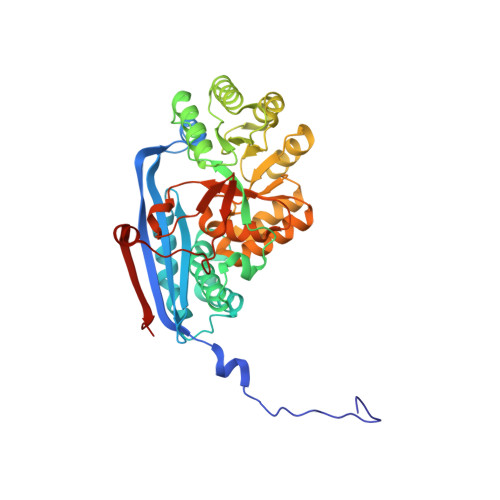Evolution of enzymatic activities in the enolase superfamily: L-talarate/galactarate dehydratase from Salmonella typhimurium LT2.
Yew, W.S., Fedorov, A.A., Fedorov, E.V., Almo, S.C., Gerlt, J.A.(2007) Biochemistry 46: 9564-9577
- PubMed: 17649980
- DOI: https://doi.org/10.1021/bi7008882
- Primary Citation of Related Structures:
2PP0, 2PP1, 2PP3 - PubMed Abstract:
We assigned l-talarate dehydratase (TalrD) and galactarate dehydratase (GalrD) functions to a group of orthologous proteins in the mechanistically diverse enolase superfamily, focusing our characterization on the protein encoded by the Salmonella typhimurium LT2 genome (GI:16766982; STM3697). Like the homologous mandelate racemase, l-fuconate dehydratase, and d-tartrate dehydratase, the active site of TalrD/GalrD contains a general acid/base Lys 197 at the end of the second beta-strand in the (beta/alpha)7beta-barrel domain, Asp 226, Glu 252, and Glu 278 as ligands for the essential Mg2+ at the ends of the third, fourth, and fifth beta-strands, a general acid/base His 328-Asp 301 dyad at the ends of the seventh and sixth beta-strands, and an electrophilic Glu 348 at the end of the eighth beta-strand. We discovered the function of STM3697 by screening a library of acid sugars; it catalyzes the efficient dehydration of both l-talarate (kcat = 2.1 s-1, kcat/Km = 9.1 x 10(3) M-1 s-1) and galactarate (kcat = 3.5 s-1, kcat/Km = 1.1 x 10(4) M-1 s-1). Because l-talarate is a previously unknown metabolite, we demonstrated that S. typhimurium LT2 can utilize l-talarate as carbon source. Insertional disruption of the gene encoding STM3697 abolishes this phenotype; this disruption also diminishes, but does not eliminate, the ability of the organism to utilize galactarate as carbon source. The dehydration of l-talarate is accompanied by competing epimerization to galactarate; little epimerization to l-talarate is observed in the dehydration of galactarate. On the basis of (1) structures of the wild type enzyme complexed with l-lyxarohydroxamate, an analogue of the enolate intermediate, and of the K197A mutant complexed with l-glucarate, a substrate for exchange of the alpha-proton, and (2) incorporation of solvent deuterium into galactarate in competition with dehydration, we conclude that Lys 197 functions as the galactarate-specific base and His 328 functions as the l-talarate-specific base. The epimerization of l-talarate to galactarate that competes with dehydration can be rationalized by partitioning of the enolate intermediate between dehydration (departure of the 3-OH group catalyzed by the conjugate acid of His 328) and epimerization (protonation on C2 by the conjugate acid of Lys 197). The promiscuous catalytic activities discovered for STM3697 highlight the evolutionary potential of a "conserved" active site architecture.
- Departments of Biochemistry and Chemistry, University of Illinois at Urbana-Champaign, 600 South Mathews Avenue, Urbana, Illinois 61801, USA.
Organizational Affiliation:


















